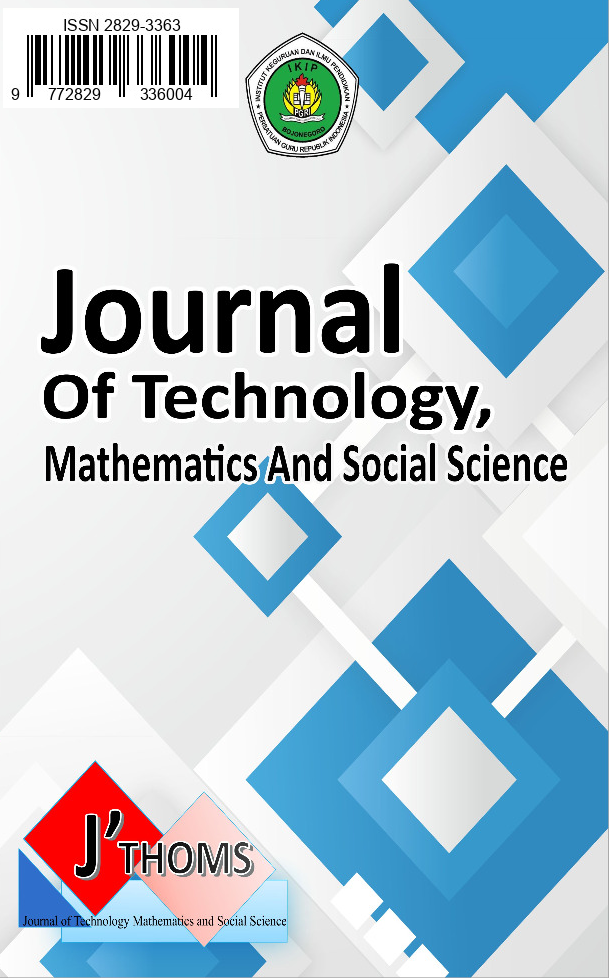PENGEMBANGAN BAHAN AJAR FUNGSI DENGAN PENDEKATAN ONDE (OPEN ENDED) UNTUK MEMBANGUN KEMANDIRIAN BELAJAR SISWA PADA SISWA MA AL-KHOIRIYAH BALEN
DOI:
https://doi.org/10.30734/j'thoms.v2i2.2959Abstract
This study aims (1) to create and develop teaching materials with an open ended approach in mathematics at MA Al-Khoiriyah Balan which can be used to build student learning independence. (2) to determine the feasibility and effectiveness of the developed teaching materials. This research includes research development (Research and Development). The model used in this research and development is the ADDIE development model. The research was conducted at MA Al-Khoiriyah Balen majoring in Mathematics and Natural Sciences involving 21 students aiming to find out the effectiveness of functional teaching materials, as well as 2 lecturers and 1 teacher as expert validators to determine the feasibility of teaching materials so that they can be used in learning. The results of the development of functional teaching materials are as follows: the results of the validation of media experts obtained an overall average of 75.4% in the "valid" category and the results of the validation of material experts consisted of two assessment aspects, namely the content aspect which received an overall average of 79 % and linguistic aspects that get an overall average of 77% in the "valid" category. The results of the study show that functional teaching materials with the ONDE (Open Ended) approach are feasible to use and effective in building student learning independence in MA Al-Khoiriyah Balen students
Keywords: teaching materials; open ended approach; student learning independence; function material
References
Arsanti, M. (2018). Pengembangan Bahan Ajar Mata Kuliah Penulisan Kreatif Bermuatan Nilai-Nilai Pendidikan Karakter Religius Bagi Mahasiswa Prodi Pbsi, Fkip, Unissula. KREDO : Jurnal Ilmiah Bahasa Dan Sastra, 1(2), 71–90. https://doi.org/10.24176/kredo.v1i2.2107
Astin, A. E., & Bharata, H. (2016). Penerapan Pendekatan Open-Ended dalam Pembelajaran Matematika terhadap Kemampuan Representasi Matematis Siswa. Prosiding: Konferensi Nasional Penelitian Matematika Dan Pembelajarannya (KNMP 1) UMS, 20, 631–639.
Bungsu, T. K., Vilardi, M., Akbar, P., & Bernard, M. (2019). Pengaruh Kemandirian Belajar Terhadap Hasil Belajar Matematika Di Smkn 1 Cihampelas. Journal on Education, 1(2), 382-389., 01(02), 382–389.
Faridah, N., & Aeni, A. N. (2016). Pendekatan Open-Ended Untuk Meningkatkan Kemampuan Berpikir Kreatif Matematis Dan Kepercayaan Diri Siswa. Jurnal Pena Ilmiah, 1(1), 1061–1070. https://doi.org/10.23819/pi.v1i1.3025
Nurhikmayati, I., & Jatisunda, M. G. (2019). Pengembangan Bahan Ajar Matematika Berbasis Scientific yang Berorientasi pada Kemampuan Berpikir Kritis Matematis Siswa. Mosharafa: Jurnal Pendidikan Matematika, 8(1), 49–60. https://doi.org/10.31980/mosharafa.v8i1.385
Sobri, M., & Moerdiyanto, M. (2014). Pengaruh Kedisiplinan Dan Kemandirian Belajar Terhadap Hasil Belajar Ekonomi Madrasah Aliyah Di Kecamatan Praya. Harmoni Sosial: Jurnal Pendidikan IPS, 1(1), 43–56. https://doi.org/10.21831/hsjpi.v1i1.2427
Syafnuri, R. A. (2016). PENGEMBANGAN BAHAN AJAR ALJABAR LINEAR DENGAN MENGGUNAKAN MODEL PEMBELAJARAN MATEMATIKA KNISLEY (Issue July).
Restianim, V., Pendy, A., & Merdja, J. (2020). Gaya belajar mahasiswa pendidikan matematika universitas flores dalam pemahaman konsep fungsi. 3.
Rizki, S., & Linuhung, N. (2017). Pengembangan Bahan Ajar Program Linear Berbasis Kontekstual Dan Ict. AKSIOMA Journal of Mathematics Education, 5(2), 137. https://doi.org/10.24127/ajpm.v5i2.674

